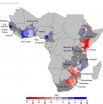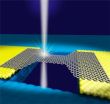(Press-News.org) (Philadelphia, PA) – Patients who have a clot in their legs and are considering whether to be treated with traditional blood-thinning medication or undergo a minimally-invasive catheter-based clot removal procedure should feel comfortable that there is no difference in death rates between the two treatments, although there are more bleeding risks with the catheter procedure, according to a study by Temple University School of Medicine researchers. The study involved a review of more than 90,000 cases nationwide.
Riyaz Bashir, MD, a specialist in interventional cardiology and vascular disease at Temple Heart & Vascular Center, directed the study, which was aimed at figuring out the best way to treat a painful and potentially deadly condition called deep vein thrombosis (DVT).
The study, to be published by JAMA Internal Medicine, compared two approaches: catheter-based thrombolysis, which involves inserting a catheter to deliver clot-dissolving medication directly into the leg clot; and medical therapy using a blood-thinning medication (anticoagulation). The study found that the in-hospital mortality rate was similar for the two groups. However, the catheter-based procedure was associated with higher rates of bleeding. The catheter procedure also was more costly than the medical therapy and involved more days in the hospital.
It is estimated that about 6 percent of DVT patients die within one month of the diagnosis. The study should help inform an ongoing medical debate over the safest and most effective way to treat DVT, which is the third most common cause of cardiovascular morbidity and death after coronary artery disease and stroke. When a blood clot develops in a vein in the leg, it can break loose and travel to the lungs, causing a deadly condition called pulmonary embolism. DVT, which occurs in about 1 out of every 1,000 people per year, can have a long-lasting effect on a person's well-being.
About 20 to 50 percent of patients with above-knee DVT will go on to develop a condition called post-thrombotic syndrome (PTS) even when treated with anticoagulation therapy and compression stockings. Patients with PTS experience pain, swelling, itching, skin discoloration and heaviness in the legs, and, in severe cases, skin ulcers.
"These patients can end up very disabled. They sometimes are unable to work and they lose their job," said Dr. Bashir, Associate Professor of Medicine. "Post-thrombotic syndrome places a huge economic burden ($2.4 billion and 200 million work days lost annually in the U.S.) on the health-care system."
Several studies had shown that early removal of the clot using catheter-directed thrombolysis (CDT) leads to a significant reduction in the incidence of PTS along with improvement in patients' quality of life. The studies were too small, however, to draw any conclusions about the safety of the catheter-based procedure versus medical therapy alone using blood-thinning medications, and doctors are divided on which approach is better. The American Heart Association recommends the catheter-based procedure (CDT) as the first-line therapy for patients at low risk for bleeding, while the American College of Chest Surgeons recommends against the use of CDT because of safety concerns and the complexity of the procedure.
Dr. Bashir and his research team used a national database called Nationwide Inpatient Sample to study outcomes for patients who were hospitalized for DVT between January 2005 and December 2010. They identified 90,618 cases overall. They then compared 3,594 patients who underwent the catheter-based procedure to deliver clot-busting medication to the same number of patients who received anticoagulation alone.
Among the findings were:
The in-hospital mortality rate was not significantly different between the two groups — 1.2 percent for those who received the catheter procedure, versus those who got medical therapy alone.
The rate of blood transfusion (a measure of bleeding) was 11.1 percent for the catheter group, versus 6. 5 percent for the medical group.
The rate of pulmonary embolism (clot in the lung) was 17.9 percent versus 11.4 percent.
The rate of intracranial hemorrhage (bleeding in the brain) was 0.9 percent for the catheter group versus 0.3 percent for the medical therapy group.
The length of hospital stay was longer for those patients who had the catheter procedure – 7 days versus 5.1 for the other group.
Hospital charges were also higher in the catheter group: $85,553 versus $29,369.
The researchers found that rate of CDT utilization for treating DVT went from 2.3 percent in 2005 to 5.9 percent in 2010. Over that same period, the mortality rate for patients who had CDT went down, which is probably a reflection in a refinement in catheter based technologies and increased operator experience. However the rate of bleeding continued to remain higher in this group of patients. Patients who had the procedure at a higher-volume center tended to do better, the study found.
Dr. Bashir said that some patients with DVT clearly benefit from the catheter based procedure, but he said patients needed to be carefully selected. His team concluded that more research is needed to sort out the risks versus the benefits of the procedure.
"In light of the findings of this study, it is imperative that the magnitude of benefit from CDT has to be substantiated in order to justify the increased upfront resource utilization and bleeding risk of this therapy," the researchers wrote. "In the absence of such data, it may be reasonable to restrict this form of therapy to those patients who have a low bleeding risk and have a high risk of PTS," such as patients with clots at or above their groins.
"I think all patients with leg clots should be informed about the risks of developing PTS and its consequences and the risks of catheter-based clot removal so that they can truly participate in shared decision-making," Dr. Bashir said.
INFORMATION:
Dr. Bashir conducted the study with three other Temple University School of Medicine researchers: Chad Zack, MD, Huaqing Zhao, PhD, and Alfred Bove, MD. Anthony Comerota, MD, of ProMedica Toledo Hospital in Ohio was also on the research team.
The study was funded by Temple University Hospital's Cardiovascular Division, which is a nationally-recognized leader in research on cardiovascular diseases and their treatments.
About Temple Health
Temple Health refers to the health, education and research activities carried out by the affiliates of Temple University Health System and by Temple University School of Medicine.
Temple University Health System (TUHS) is a $1.4 billion academic health system dedicated to providing access to quality patient care and supporting excellence in medical education and research. The Health System consists of Temple University Hospital (TUH), ranked among the "Best Hospitals" in the region by U.S. News & World Report; TUH-Episcopal Campus; TUH-Northeastern Campus; Fox Chase Cancer Center, an NCI-designated comprehensive cancer center; Jeanes Hospital, a community-based hospital offering medical, surgical and emergency services; Temple Transport Team, a ground and air-ambulance company; and Temple Physicians, Inc., a network of community-based specialty and primary-care physician practices. TUHS is affiliated with Temple University School of Medicine.
Temple University School of Medicine (TUSM), established in 1901, is one of the nation's leading medical schools. Each year, the School of Medicine educates approximately 840 medical students and 140 graduate students. Based on its level of funding from the National Institutes of Health, Temple University School of Medicine is the second-highest ranked medical school in Philadelphia and the third-highest in the Commonwealth of Pennsylvania. According to U.S. News & World Report, TUSM is among the top 10 most applied-to medical schools in the nation.
Temple study compares deep vein thrombosis therapies
Research examines safety of treatments for deep vein thrombosis
2014-07-21
ELSE PRESS RELEASES FROM THIS DATE:
'Moral victories' might spare you from losing again
2014-07-21
It's human nature to hate losing.
Unfortunately, it's also human nature to overreact to a loss, potentially abandoning a solid strategy and thus increasing your chances of losing the next time around.
That's one conclusion of a Brigham Young University study published this week by the journal Management Science. The finding is based on an analysis of two decades of data on NBA coaching decisions.
The researchers focused on whether coaches adjusted their personnel following games where the margin of victory or defeat was small. After narrow wins, coaches changed their ...
Water, water -- not everywhere: Mapping water trends for African maize
2014-07-21
Today's food production relies heavily on irrigation, but across sub-Saharan Africa only 4 percent of cultivated land is irrigated, compared with a global average of 18 percent. Small-scale farming is the main livelihood for many people in the region, who depend on rainfall to water their crops.
To understand how climate change may affect the availability of water for agriculture, researchers at Princeton University analyzed trends in the water cycle in maize-growing areas of 21 African countries between 1979 and 2010. The team examined both levels of rainfall and the ...
Global warming 'pause' since 1998 reflects natural fluctuation
2014-07-21
Statistical analysis of average global temperatures between 1998 and 2013 shows that the slowdown in global warming during this period is consistent with natural variations in temperature, according to research by McGill University physics professor Shaun Lovejoy.
In a paper published this month in Geophysical Research Letters, Lovejoy concludes that a natural cooling fluctuation during this period largely masked the warming effects of a continued increase in man-made emissions of carbon dioxide and other greenhouse gases.
The new study applies a statistical methodology ...
Mammoth and mastodon behavior was less roam, more stay at home
2014-07-21
Their scruffy beards weren't ironic, but there are reasons mammoths and mastodons could have been the hipsters of the Ice Age.
According to research from the University of Cincinnati, the famously fuzzy relatives of elephants liked living in Greater Cincinnati long before it was trendy – at the end of the last ice age. A study led by Brooke Crowley, an assistant professor of geology and anthropology, shows the ancient proboscideans enjoyed the area so much they likely were year-round residents and not nomadic migrants as previously thought.
They even had their own ...
NIH-supported scientists demonstrate very early formation of SIV reservoir
2014-07-21
WHAT:
Scientists have generally believed that HIV and its monkey equivalent, SIV, gain a permanent foothold in the body very early after infection, making it difficult to completely eliminate the virus even after antiretroviral therapy has controlled it. Now NIH-supported researchers report that SIV can become entrenched in tissues fewer than 3 days after infection, before the virus is detectable in blood plasma (the liquid part) or blood cells.
Led by Dan H. Barouch, M.D., Ph.D., of Beth Israel Deaconess Medical Center and the Ragon Institute, in collaboration with ...
National survey from AP-NORC examines perceptions of health care provider quality
2014-07-21
Chicago, July 20, 2014—The Associated Press-NORC Center for Public Affairs Research has released the results of a major survey examining the public's opinions about what it means to be a quality health care provider in the United States. The survey, funded by the Robert Wood Johnson Foundation, sheds new light on how American adults perceive the quality of their health care and doctors, as well as the information they use and trust when making health care decisions. The survey produces new and actionable data during a crucial period of Affordable Care Act (ACA) implementation. ...
Try, try again? Study says no
2014-07-21
CAMBRIDGE, MA -- When it comes to learning languages, adults and children have different strengths. Adults excel at absorbing the vocabulary needed to navigate a grocery store or order food in a restaurant, but children have an uncanny ability to pick up on subtle nuances of language that often elude adults. Within months of living in a foreign country, a young child may speak a second language like a native speaker.
Brain structure plays an important role in this "sensitive period" for learning language, which is believed to end around adolescence. The young brain is ...
Fires and Smoke in Canada's Northern Territories
2014-07-21
Environment Canada has issued a high health risk warning for Yellowknife and surrounding area because of heavy smoke in the region due to forest fires. Currently 160 wildfires are burning across the region. There are no plans for evacuation since these fires are endangering people or property. Weather that has been hitting the area recently comes with mixed results. The rains help to dampen the fires, but the lightning tends to start others.
This year the Northern Territories have seen 855,000 hectares (over 2,100,000 acres) burned as opposed to the territories 10 ...
Researchers provide guide to household water conservation
2014-07-21
BLOOMINGTON, Ind. -- Want to conserve water and save on your utility bill? A paper co-written by an Indiana University researcher and published in the current issue of the journal Environment can help.
"The Water Short List: The Most Effective Actions U.S. Households Can Take to Curb Water Use" describes how households can reduce water use substantially by simple actions such as installing more efficient appliances and changing day-to-day habits involving water consumption. While the suggestions may be familiar, the researchers are the first to put a comprehensive, quantitative ...
Penn study: Understanding graphene's electrical properties on an atomic level
2014-07-21
Graphene, a material that consists of a lattice of carbon atoms, one atom thick, is widely touted as being the most electrically conductive material ever studied. However, not all graphene is the same. With so few atoms comprising the entirety of the material, the arrangement of each one has an impact on its overall function.
Now, for the first time, researchers from the University of Pennsylvania have used a cutting-edge microscope to study the relationship between the atomic geometry of a ribbon of graphene and its electrical properties.
A deeper understanding of ...
LAST 30 PRESS RELEASES:
Tracing the quick synthesis of an industrially important catalyst
New software sheds light on cancer’s hidden genetic networks
UT Health San Antonio awarded $3 million in CPRIT grants to bolster cancer research and prevention efforts in South Texas
Third symposium spotlights global challenge of new contaminants in China’s fight against pollution
From straw to soil harmony: International team reveals how biochar supercharges carbon-smart farming
Myeloma: How AI is redrawing the map of cancer care
Manhattan E. Charurat, Ph.D., MHS invested as the Homer and Martha Gudelsky Distinguished Professor in Medicine at the University of Maryland School of Medicine
Insilico Medicine’s Pharma.AI Q4 Winter Launch Recap: Revolutionizing drug discovery with cutting-edge AI innovations, accelerating the path to pharmaceutical superintelligence
Nanoplastics have diet-dependent impacts on digestive system health
Brain neuron death occurs throughout life and increases with age, a natural human protein drug may halt neuron death in Alzheimer’s disease
SPIE and CLP announce the recipients of the 2025 Advanced Photonics Young Innovator Award
Lessons from the Caldor Fire’s Christmas Valley ‘Miracle’
Ant societies rose by trading individual protection for collective power
Research reveals how ancient viral DNA shapes early embryonic development
A molecular gatekeeper that controls protein synthesis
New ‘cloaking device’ concept to shield sensitive tech from magnetic fields
Researchers show impact of mountain building and climate change on alpine biodiversity
Study models the transition from Neanderthals to modern humans in Europe
University of Phoenix College of Doctoral Studies releases white paper on AI-driven skilling to reduce burnout and restore worker autonomy
AIs fail at the game of visual “telephone”
The levers for a sustainable food system
Potential changes in US homelessness by ending federal support for housing first programs
Vulnerability of large language models to prompt injection when providing medical advice
Researchers develop new system for high-energy-density, long-life, multi-electron transfer bromine-based flow batteries
Ending federal support for housing first programs could increase U.S. homelessness by 5% in one year, new JAMA study finds
New research uncovers molecular ‘safety switch’ shielding cancers from immune attack
Bacteria resisting viral infection can still sink carbon to ocean floor
Younger biological age may increase depression risk in older women during COVID-19
Bharat Innovates 2026 National Basecamp Showcases India’s Most Promising Deep-Tech Ventures
Here’s what determines whether your income level rises or falls
[Press-News.org] Temple study compares deep vein thrombosis therapiesResearch examines safety of treatments for deep vein thrombosis



